AMD 6nm Ryzen 6000 'Rembrandt' SoC Deep Dive: Gunning For Alder Lake
Zen 3+, 6nm TSMC and RDNA 2 collide
AMD whipped the covers off of its promising Ryzen 6000 'Rembrandt' mobile processors at CES 2022, with standout features including the new Zen 3+ CPU architecture and RDNA 2 integrated graphics fabbed on TSMC's 6nm node. Today marks the launch of the inaugural 35W HS-series models that attack the thin-and-light market and can boost up to 5.0 GHz on the flagship model. AMD also introduced a new Radeon 600M Series branding for its integrated graphics.
AMD is quite scathing in its assessment of Intel's new Alder Lake processors, calling into question the company's x86 hybrid approach as it claims the Ryzen 6000 chips have better performance, performance-per-watt, and battery life. AMD's representatives were clear in our briefings: They believe that Ryzen 6000's Zen 3+ cores offer more power efficiency than Alder Lake's Efficiency cores and more performance than its Performance cores, but all with one group of eight high-performance Zen 3+ cores that AMD claims have a superior dynamic range.
AMD also believes that Intel will have scalability issues as it moves down from the 110W "max effort" notebooks we saw in early reviews into 35W, 28W, and 15W notebooks that serve the vast majority of the market. So naturally, AMD believes this will result in performance and battery life advantages for Ryzen 6000. In fact, AMD even claims that Intel has to use efficiency cores because it can't cram eight performance cores into 28W and 15W ultrathin notebooks, while Ryzen 6000 offers eight full-performance cores across its full product stack. AMD claims that Intel continues to face issues because it hasn't actually fixed its process node issues.
AMD's claims are bold, but the company is obviously aware that it will have to back those statements up with its shipping products. That begins today with the first wave of 200+ Ryzen 6000 designs that will work their way to market over the next several months.




Above, we can see the HS-series models that come to market with the first wave, along with the HX- and U-series models that arrive in March. AMD has carved these into three swim lanes based on device form factor/thickness. Notably, the last slide shows the three refreshed Ryzen 5000 'Cezanne' models that are included in the Ryzen 6000 family (bottom of the table).
Ryzen 6000 brings a slew of technological advancements that all begin with AMD's focus on thin-and-light machines that are 18mm thicker or less, a strategy that aims to cater to what the company says is the fastest-growing segment and serves 85% of the market. According to AMD, this segment prizes battery life just as much as performance and wants leading performance wrapped in a thin and light chassis that can serve multiple uses, as opposed to the focus on sheer performance that we see with the halo 'Ultra Enthusiast' class machines for gamers and creators. In fact, AMD says some of the thin-and-light models will eventually provide up to 24 hours of battery life (as measured by video playback), though we shouldn't expect to see those until the May to June timeframe (they require an 'optimized set of components').
With a focus on maximum performance density, AMD transitioned the chips to the 6nm TSMC process and relied heavily on power optimizations instead of increasing IPC or making microarchitectural changes. However, the move from 7nm to 6nm allows the company to cram in more features per square millimeter of silicon — TSMC’s 6nm process offers up to 18% higher logic density than the 7nm “N7” process, but similar power and performance metrics.
Paired with fine-grained power improvements, drastically improved I/O like DDR5/LPDDR5, and the new RDNA 2 engine that features higher peak clock speeds and IPC over the prior-gen Cezanne chips, the Ryzen 6000 'Rembrandt' chips look to wring impressive gains out of the new revamped Zen 3+ architecture. Here's how they did it, plus some of the company's benchmarks.
Five Layers of Power



AMD focused its power refinements on the five optimization points listed in the above slide. As you can see, AMD claims performance/power/area (PPA) benefits from the TSMC 6nm 'N6' process it used in pursuit of its goal for the most performance-per-watt and performance-per-square-millimeter of silicon.
The second slide in the above album gives us a look at the SoC topology, with key features including the move from the DDR4/LPDDR4X interface to only DDR5-5200 and LPDDR5-6400 interfaces. Those interfaces connect via dual 128-bit wide memory controllers (two sub-channels). These four 32-bit channels combine to deliver a tremendous throughput advantage over DDR4/X, thus feeding the RDNA 2 engine with much more bandwidth.
Notably, the lack of support for DDR4 interfaces means that Ryzen 6000 laptops are exposed to higher DDR5 pricing that isn't a good fit for the value end of the market, but AMD says that it will use three refreshed Cezanne models with Vega graphics for lower-end designs.
We've also included the Ryzen 5000 block diagram in the album for comparison. You'll also notice that Ryzen 6000 includes the new Microsoft Pluton security co-processor, which adds more functionality and "Xbox-class" security in addition to AMD's existing Platform Security Processor (PSP). The PSP still controls firmware authentication for secure boot, mapped I/O during runtime, and a cryptographic engine for security purposes. The Pluton processor steps in for fTPM functionality and additional OS-directed features.
6nm Process and Core Architecture
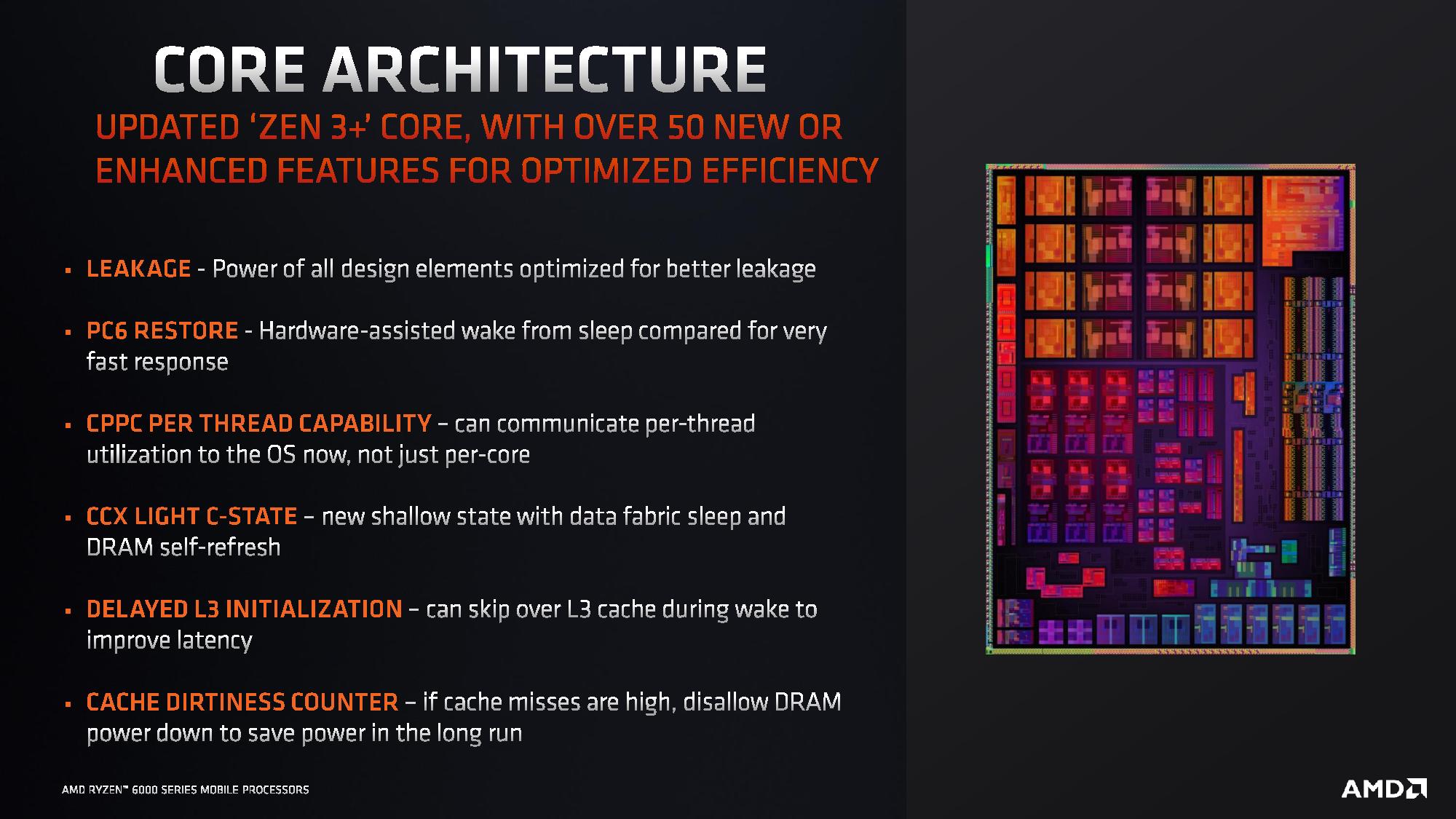

AMD moved from 7nm to 6nm. Still, it also optimized transistor placement to use faster, leakier transistors in performance-sensitive areas, like critical pathways, while using slower, more efficient transistors for other areas.
AMD says it added 50 new features to the core and focused on new, deeper sleep states to reduce power consumption. These power savings ultimately increase battery life and free up additional thermal headroom for higher boost clocks during bursty work. The new PC6 Restore feature is particularly important here. This feature allows AMD to move from firmware-assisted resumption from sleep states to a fully hardware-accelerated approach, speeding up resumption by 4X.
AMD's CPPC feature allows the OS to target workloads at specific cores, which is important because only two of the physical cores can reach the peak boost frequency. AMD has further tightened its core telemetry, so now the chip can communicate and accept thread placements on a per-thread basis (logical core vs physical core), allowing for optimized thread targeting.
Other optimizations include CCX Light C-State, which allows the Infinity Fabric to drop into a sleep state when the cores are working from the cache and don't require data from other sources. Delayed L3 Initialization prevents lighting up the L3 cache just to flush it during wake tasks, or when the cores only need data from RAM.
The Cache Dirtiness Counter prevents shifting the DRAM into sleep modes if the system is frequently fetching data from the main memory due to a high cache miss ratio. This not only saves power but also reduces latency, as DRAM is comparatively slow to re-wake from sleep states.
Speaking of cache, AMD says that Rembrandt has no cache latency improvements over Cezanne.
Get Tom's Hardware's best news and in-depth reviews, straight to your inbox.
SoC Architecture



Rembrandt's SoC redesign features rearchitected power domains and a more efficient control plane for those domains (including hardware-assisted transitions in and out of sleep). Here we can see that AMD carved the chip up into six power domains instead of the previous-gen's three power planes. This allows tighter power-gating, thus providing more granularity for the internal and external power rails to improve power efficiency and reduce the time it takes for the various regions to enter and resume from sleep. This also allows each region to operate within its optimal point on the voltage/frequency curve.
You'll notice the new Z-state region in the lower right corner of the die diagram. This area controls the new hardware-assisted Z10 and Z9 sleep states, with the former basically shutting down the processor entirely while the latter turns off the chip but leaves the display on. This region is also power-gated.
AMD has long used a System Management Unit (SMU) to control voltages based on sensory data, but the SoC included only a single SMU. With Rembrandt, AMD has added remote SMUs, which are smaller SMUs spread around the various chip elements that can control clock gating and power gating autonomously, and thus faster, based on budgets assigned by the central SMU.
The Infinity Fabric (data fabric) can now drop into enhanced sleep states when it isn't busy, and the memory and fabric can dynamically adjust bandwidth in real-time to save power. This is particularly useful when the bandwidth-hogging RDNA 2 graphics aren't active, as the CPU rarely saturates the data fabric.
Speaking of RDNA 2, the graphics engine boosts up to 300 MHz higher than the Vega graphics found on the previous-gen APUs (yes, AMD skipped RDNA 1 entirely for its APUs) and has better IPC. AMD uses the same approaches of deep sleep states, power gating, and dynamic clock adjustments to provide the optimal balance of power and performance for the graphics engine.
System Software
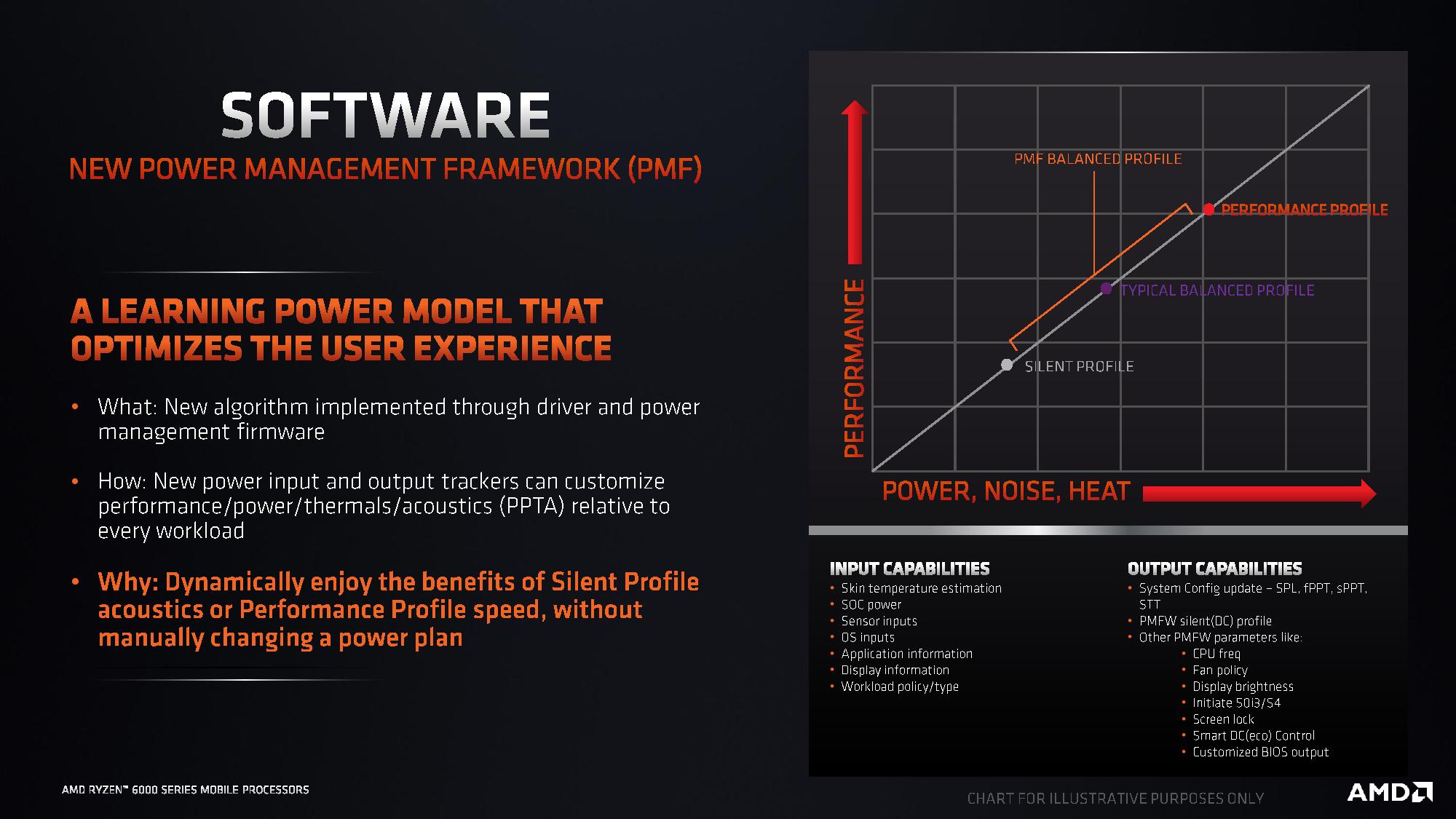
AMD's new firmware-based power profile dynamically adapts to user activity to provide an optimal balance of performance, power, thermals, and acoustics (PPTA) for the user. This approach eschews the standard paradigm of Windows power plans, like Balanced, High Performance, and Silent. Instead, it turns to an adaptive algorithm that resides in the driver and power management firmware.
This Power Management Framework (PMF) algorithm analyzes data from a whole slew of inputs, like human presence detection, skin temperature, SoC, and so on (listed in the slide), to customize PPTA for every workload on the fly. You can dictate your overall preference for the type of profile you prefer by using the Windows power slider or the OEMs software. Still, you can also override PMF by simply selecting a standard Windows power plan. Unfortunately, this feature won't come standard on all Ryzen 6000-powered devices. Instead, it will require vendor enablement, so support will vary.
AMD Radeon 600M Series Benchmarks - RDNA 2 Comes to APUs






AMD moved from the Vega graphics found in Cezanne directly to Navi for Rembrandt, meaning it skipped RDNA 1 entirely in favor of what it calls a full implementation of RDNA 2 for Rembrandt. AMD also slapped Radeon branding on the new integrated graphics engine.
The iGPU known as Radeon 680M comes with 12 cores that boost up to 2.4 GHz and four render backends, delivering up to 3.4 TFLOPS of FP32 and 6.8 TFLOPS of FP16. The lower-end Radeon 660M has six cores that boost up to 1.9 GHz and two render backends.
The iGPU includes up to a 50% larger execution engine, 1.5X the memory bandwidth courtesy of LPDDR5X, 2X larger L2 caches, and 2X larger render backends. Rembrandt also supports DirectX 12 Ultimate, FSR, and Radeon Super Resolution (RSR - coming Spring 2022).
AMD touts the 300 MHz higher boost clock and Navi's higher IPC, which combine to provide up to twice the iGPU performance, as enabling 1080p gaming in thin-and-light devices (albeit with lowered fidelity in some titles).
AMD provided the benchmarks in the above album, and as with all vendor-provided benchmarks, take them with a shovelful of salt (we've included the test notes at the end of the article). AMD compared its Ryzen 7 6800U to an Intel Tiger Lake Core i7-1185G7. AMD also included comparisons to the Nvidia GeForce GTX 1650 Max-Q discrete graphics, with the addition of FSR and RSR giving it a boost to take the lead.
Platform and New Uncore





Ryzen 6000 supports plenty of connectivity options, with support for LPDDR5 and DDR5 memory, PCIe 4.0 connectivity, USB4 at 40 Gbps (20 Gbps is not an option), WiFi 6E with dual-band simultaneous capabilities, Bluetooth LE 5.2, and AV1 hardware decode (unfortunately, we don't see AV1 hardware encode support).
USB4 is integrated directly into the chip, so no external chip is needed, while WLAN connectivity continues to use an external module. Additionally, other connectivity options, like 5G LTE modems, will also hang off the PCIe bus, meaning they'll use an external chip. Meanwhile, Thunderbolt 4 certification is done on a per-notebook-model basis, so not all systems will be certified.
AMD says it went with the PCIe 4.0 connection because it is better for power efficiency (lower pj/bit) for both GPU and storage devices.
AMD threw in AI noise cancellation tech for good measure. This tech works via a partnership with Realtek, so not all systems support it. However, AMD uses Realtek's pre-trained neural network for noise and echo cancellation. This neural net runs on Ryzen 6000's DSP, which the company claims uses far less power than GPU-powered alternatives.
AMD's work to support the latest technologies is ongoing, with support added for new features like Panel Self Refresh-Self Update (PSR-SU). This tech allows the display to save power by only updating the sections of the screen that have changed between refreshes, which saves power. AMD has also moved to an SVI3 regulator that provides faster, more granular voltage supply control.
The second slide includes an impressive list of display capabilities. Notably, AMD has worked with the HDMI standards body behind the HDMI 2.1 spec as it was developed, so the hardware fully supports the interface even though it isn't released yet.
AMD's Ryzen 6000 Benchmarks
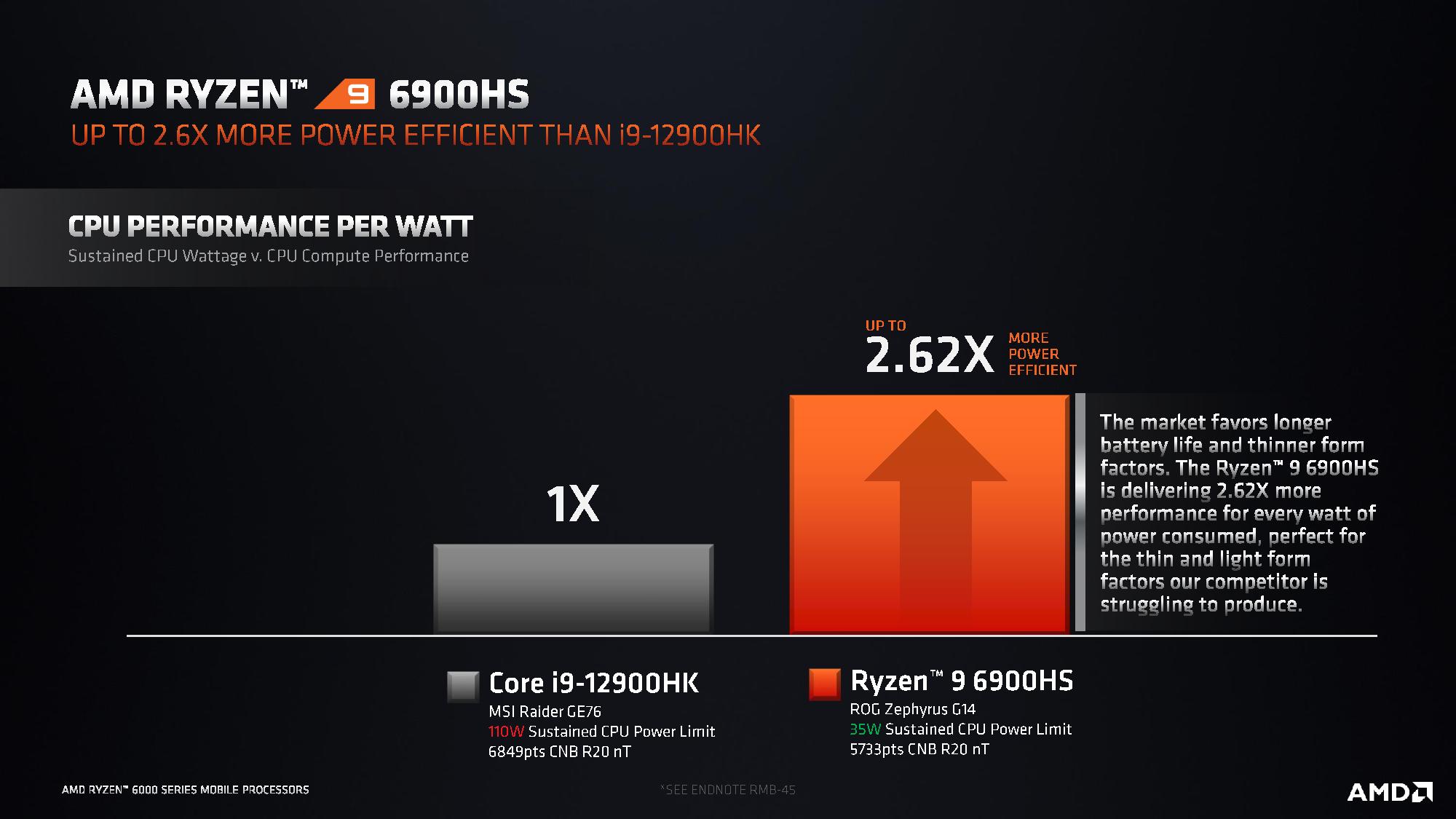



Here we can see some more of AMD's performance claims, and many of these are questionable. For instance, the first slide is based on AMD's napkin math using online performance results from Intel's Core i9-12900HK. AMD did some basic math here to calculate performance-per-watt based on the multi-threaded Cinebench benchmark, thus claiming the Ryzen 9 6900HS delivers up to 2.6X more performance per watt than the Core i9-12900HK.
However, while the slide does point out that the 12900HK has a 110W sustained power limit, the chip is obviously tuned/running in the upper end of the voltage/frequency curve where it is least efficient, but that's only possible because it is in a ridiculously well-accommodated chassis with incredible cooling capacity. As such, the Intel chip clearly isn't running in the optimized lower v/f range like the 35W Ryzen 9 6900HS. As such, comparing power efficiency between the two models isn't indicative of what we'll see with lower-TDP Alder Lake models, or similar 45W models in a more mainstream chassis. That means this is a bit of an apple-and-oranges comparison.
AMD also provided a few benchmarks highlighting the performance and battery life gains from moving from a Ryzen 5000 notebook to Ryzen 6000.





AMD also provided a series of benchmarks comparing gen-on-gen 15W-vs-15W and 15W-vs-28W performance in a range of benchmarks, showing strong uplift. However, these slides also include the Tiger Lake Core i7-1185G7 as a punching bag of sorts, but be aware that these results aren't representative of what we'll see against Ryzen 6000's real competitor, Alder Lake.
We also see the Ryzen 9 6900HX up against the previous-gen Core i9-11980HK, and AMD claims that we would see a similar delta even if the comparison included a new Alder Lake chip. Again, take those claims with plenty of salt.
AMD Endnotes







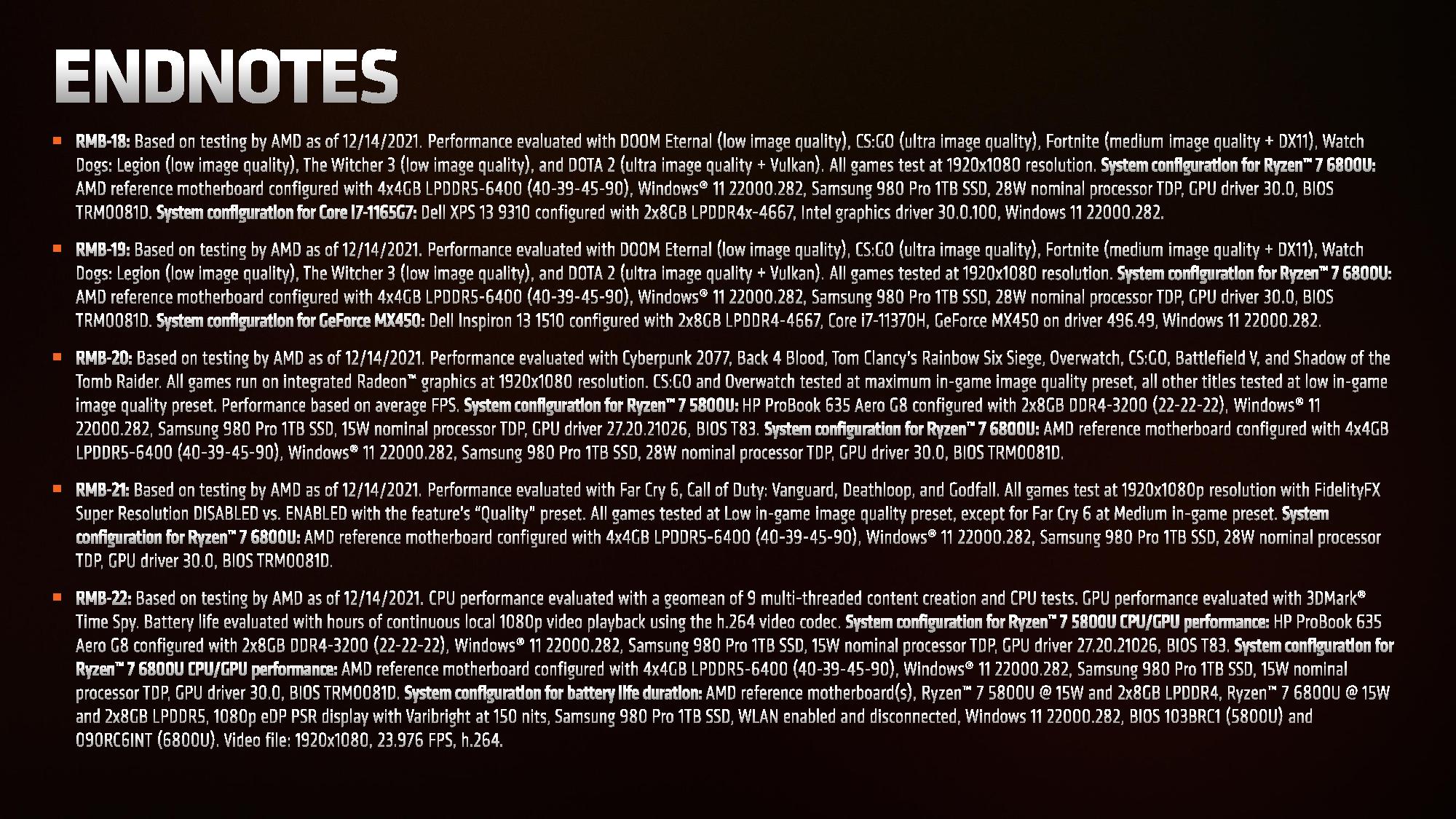


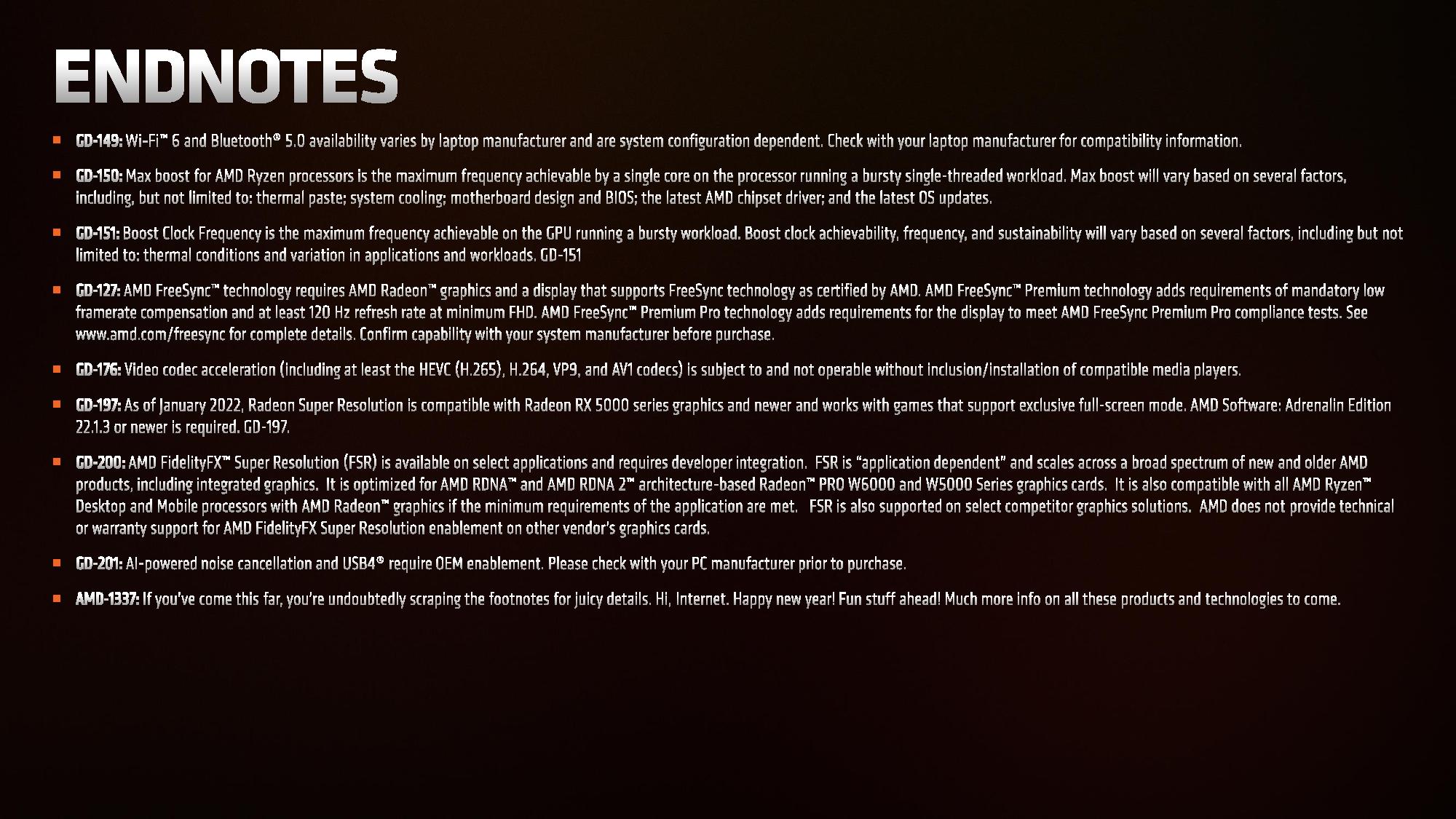

- MORE: Best CPUs for Gaming
- MORE: CPU Benchmark Hierarchy
- MORE: AMD vs Intel
- MORE: All CPUs Content

Paul Alcorn is the Editor-in-Chief for Tom's Hardware US. He also writes news and reviews on CPUs, storage, and enterprise hardware.
-
jkflipflop98 I hope AMD enjoyed their little moment in the sun. It's quickly coming to an end.Reply -
helper800 Reply
What are you talking about? Intel may have a performance advantage at the ultra high end of laptops but in the high to mid market segment they will rule with performance per watt and entry level gaming without discrete graphics thus saving cost. AMD is going to continue to gain market share in the mobile sector.jkflipflop98 said:I hope AMD enjoyed their little moment in the sun. It's quickly coming to an end. -
gggplaya RDNA 2 should make these chips solid 1080p medium/high performers. With graphics cards prices still high, and not being able to mine on integrated graphics, then these might be the best option for system builders that can't buy a graphics card right now.Reply -
wifiburger Reply
"AMD is going to continue to gain market share in the mobile sector"helper800 said:What are you talking about? Intel may have a performance advantage at the ultra high end of laptops but in the high to mid market segment they will rule with performance per watt and entry level gaming without discrete graphics thus saving cost. AMD is going to continue to gain market share in the mobile sector.
yeah... no TMSC fabs are limited & AMD volume is crap because of that vs Intel
why you have so much Intel on OEM / Laptops... ? Volume
OEM & Laptop manufactures don't really care about AMD since they know their business won't go anywhere waiting for AMD inventory
Also waiting 1.5years+ for cpu desktop generation is one garbage strategy for a tech compnay that try to boost their data centre, oem & mobile market share and ingore desktop users that got them here since Zen started ! -
helper800 Reply
Well we shall see what happens in the future, not to say that I am correct. Best regards.wifiburger said:"AMD is going to continue to gain market share in the mobile sector"
yeah... no TMSC fabs are limited & AMD volume is crap because of that vs Intel
why you have so much Intel on OEM / Laptops... ? Volume
OEM & Laptop manufactures don't really care about AMD since they know their business won't go anywhere waiting for AMD inventory
Also waiting 1.5years+ for cpu desktop generation is one garbage strategy for a tech compnay that try to boost their data centre, oem & mobile market share and ingore desktop users that got them here since Zen started ! -
spongiemaster Reply
I wouldn't bet money on that. AMD oddly lost market share in the mobile sector last quarter and Intel's mobile Alder Lake didn't hit the market until this quarter. I would expect Intel to see a significant boost in mobile sales with Alder Lake and their production capacity dwarfs what AMD is likely to request from TSMC for Rembrandt.helper800 said:AMD is going to continue to gain market share in the mobile sector. -
helper800 Reply
I expect them to continue gaining market share though they did lose some for reasons I cannot explain last quarter. This new generation seems like a big push by AMD for gaining market share, but like I said I could be wrong. The trend has definitely been AMD eating into Intel mobile market share over the last 2 years or so.spongiemaster said:I wouldn't bet money on that. AMD oddly lost market share in the mobile sector last quarter and Intel's mobile Alder Lake didn't hit the market until this quarter. I would expect Intel to see a significant boost in mobile sales with Alder Lake and their production capacity dwarfs what AMD is likely to request from TSMC for Rembrandt. -
TerryLaze Reply
First of all that would be a pretty bad strategy for AMD selling RDNA cores for cheap on mobile instead of getting more from them by selling them on GPUs, unless the mobile cores are lower quality to begin with.gggplaya said:RDNA 2 should make these chips solid 1080p medium/high performers. With graphics cards prices still high, and not being able to mine on integrated graphics, then these might be the best option for system builders that can't buy a graphics card right now.
But also secondly, we will have to see how Xe works out for intel as igpus, but also if they will offer discreet mobile Xe to OEMs for free or very low cost with the sale of each CPU just to get a big user base. -
InvalidError Reply
I can think of one really simple and probable reason: supply constraints. Can't grow market share when you run out of parts to sell or other parts of the supply chain is bottlenecked by components such as VRM chips.helper800 said:I expect them to continue gaining market share though they did lose some for reasons I cannot explain last quarter.
The 680M IGP has only 12 SM cores sharing system memory bandwidth while the RX6500 has 16 cores with dedicated memory bandwidth. People who want performance consistently better than a GTX1050Ti will still need discrete graphics. Doesn't make much sense to pair the lowest-end discrete graphics with the highest-end IGP though, so the RX6500 would make more sense when paired with APUs that have the 660M IGP.TerryLaze said:First of all that would be a pretty bad strategy for AMD selling RDNA cores for cheap on mobile instead of getting more from them by selling them on GPUs, unless the mobile cores are lower quality to begin with. -
wifiburger Replygggplaya said:RDNA 2 should make these chips solid 1080p medium/high performers. With graphics cards prices still high, and not being able to mine on integrated graphics, then these might be the best option for system builders that can't buy a graphics card right now.
"RDNA 2 should make these chips solid 1080p medium/high performers"
lol, you mean like that 6500xt ?
can't wait to buy a new laptop to get 10year old console graphics:rolleyes: